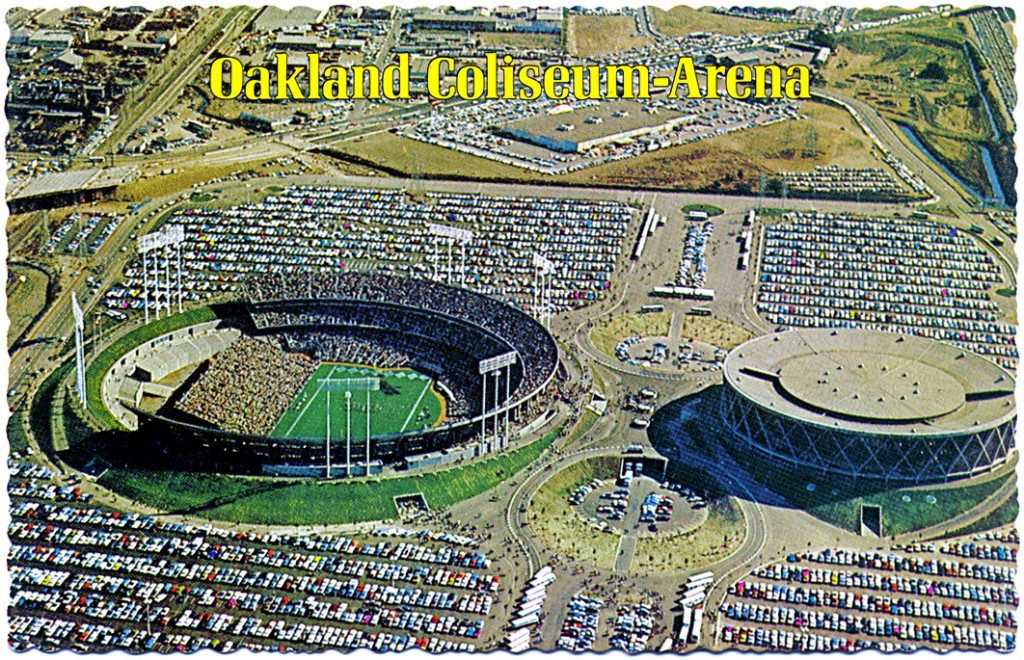As we noted two weeks ago, this year marks the 50th anniversary of a watershed moment in modern professional sports, as the NHL expanded from the Original Six to 12 teams, introducing six new arenas into the sports fraternity.
In professional basketball, the 1967-68 season was no less seismic, as an entire new league, the American Basketball Association, took flight for one of the most colorful, and ultimately triumphant, decades of play.
The 11-team basketball league that would give us the three-point shot, Dr. J, and a merger with the NBA in 1976 also gave us some of the more unlikely home courts in sports history. Three of the teams would share arenas with three of the new NHL expansion teams. The eight other arenas ranged from an armory to a field house to a convention center, and everything in between.
Here is a look at the original 11 homes of the ABA:
Pittsburgh Civic Arena
The Pittsburgh Pipers would become the first league champion in ABA history, and fitting for the fledgling, out-there league, the defending champs would move to a new city even after its title-winning inaugural season.
Built in 1961, the Civic Arena (above) would become famous in Pittsburgh as the home of the NHL Penguins, which won a pair of Stanley Cups at “The Igloo” in the early 1990s. But the basketball connection to the Arena would extend beyond the Pipers. The iconic basketball movie, The Fish That Saved Pittsburgh, would be filmed at the Civic Arena in the late 1970s.
The Civic Arena would stand for 50 years in Pittsburgh, before its demolition began in 2011.
Metropolitan Sports Center
The Minnesota Muskies were a one-year wonder in the ABA, and “The Met,” which opened in 1967, was another arena better known for the expansion NHL franchise that began play that same 1967-68 season, the North Stars. The Muskies gave way to the Pipers in 1968, and then the Pipers moved back to Pittsburgh in 1969.
But it was the North Stars’ departure to Dallas in 1993 that doomed the Met. It was demolished in 1994.
Indiana State Fairgrounds Coliseum
The future first home of the Indiana Pacers opened in 1939 and would become one of the most versatile arenas in Indianapolis. Now the home of the Indy Fuel of the ECHL, the Coliseum is perhaps best known for hosting the Beatles in 1964.
That foursome gave way to a starting five in the ABA, and the Pacers would become one of the most successful franchise in league history, winning three titles in a span of four seasons (1970, ’72, ’73), before the Pacers moved on to Market Square Arena in 1974 and ultimately the NBA in the merger of 1976.
The Pacers would pay homage to their first home in 2008, when they played an exhibition game against the New Orleans Hornets at the Coliseum.
Louisville Convention Center
The oldest arena in the ABA belonged to the Kentucky Colonels. The Louisville Convention Center was built in 1905 and still stands today, now known as Louisville Gardens. The Convention Center, originally called the Jefferson County Armory, has a long basketball tradition, as the University of Louisville played there primarily before Freedom Hall opened.
The Convention Center made history with the Colonels, as Penny Ann Early became the first woman to play in a professional men’s basketball league in a game in 1968. The Colonels played three seasons at the Convention Center before moving to Freedom Hall in 1970.
Teaneck Armory
Before they became the Nets, and before they joined the NBA, the New Jersey entry in the ABA was known as the Americans. And their home-court history was the most unique — and bizarre — in league history.
Teaneck Armory, built in 1936 and still in use today, was the original home of the Americans in what was a successful first season, ending in a tie with the Colonels for the league’s fourth and final playoff spot. A one-game playoff was scheduled for New Jersey on March 23, 1968. But the Armory was not available because of a circus that was already booked for that date.
Instead, the Americans moved the game to Commack Arena on Long Island. Big mistake.
What the Americans failed to do was scout their backup building. The court at Commack was littered with holes and other dysfunctions, such as baskets at different heights. Commissioner George Mikan was left with no choice but to declare a forfeit in favor of the Colonels.
The team was clearly undaunted. After its lone season at Teaneck Armory, the team (now renamed the Nets) moved — to Commack Arena (!) — for the 1968-69 season.
Loyola Field House
The New Orleans Buccaneers were the other league finalist in the first season of 1967-68. The Bucs would play two seasons at the Loyola Field House, built for the Loyola University basketball program in 1954, and then spent split their final season in New Orleans between Tulane Gym and Municipal Auditorium before moving to Memphis in 1970.
The NBA expansion New Orleans Jazz would play some of its home games in its first season of 1974-75 at the 6,500-seat Field House, which was demolished in 1980s.
Moody Coliseum
The home of the Southern Methodist Mustangs since its opening in 1956, Moody Coliseum played home to the Dallas entry in the ABA in 1967 and would be the third-most consistent home court in the league, hosting the Chaparrals until 1973, when the franchise moved to San Antonio, and later joined the NBA as the Spurs.
The 7,000-seat arena continues to this day as the home of SMU basketball. It was also the site of an NBA playoff game in 1984, when the Dallas Mavericks hosted the Seattle SuperSonics in Game 5 of the Western Conference first round series.
Denver Auditorium Arena
The second-oldest arena in the ABA, Denver Auditorium Arena was built in 1908. The Auditorium would be the most stable home of any ABA franchise, hosting the Rockets (they became the Nuggets in 1974) for all but one season in the franchise’s decade in the league, leaving for McNichols Arena in 1975 in advance of Denver’s merger into the NBA.
Sam Houston Coliseum
Denver had the Rockets and Dallas now has the Mavericks. But in 1967, Houston’s team was the Mavericks and they were arguably the worst franchise in the early days of the ABA. The Mavericks played at Sam Houston Coliseum, which opened in 1937 and came down in 1998.
In 1967, Sam Houston held 9,200, but that number was never needed for the Mavericks. In their two seasons before relocating to North Carolina, the Mavericks rarely drew over 500 fans and their final game at Sam Houston had an attendance of 89.
Anaheim Convention Center
The most famous basketball game ever played in Anaheim came in 1992, when the Rodney King riots forced a playoff game between the Clippers and Jazz to be moved to the Convention Center.
But a quarter-century earlier, the Anaheim Amigos called the Convention Center home. But it was a temporary home, as the Amigos moved to the Sports Arena in L.A. in 1968 and became the Los Angeles Stars. That team would play in LA for two seasons, then relocate to Utah in 1970 and win the ABA championship, setting the stage for the arrival of the Jazz from New Orleans in 1979.
Oakland-Alameda County Coliseum Arena
No one remembers the Oakland Oaks. But everyone knows about the arena they played in. It is the only original ABA arena still in use for professional basketball as the home of the Golden State Warriors. Like Civic Arena in Pittsburgh and The Met in Minnesota, the Coliseum Arena also hosted NHL expansion hockey. The Oaks would play two seasons in Oakland before moving to Washington D.C. in 1970. The Warriors, which played at what is now known as Oracle Arena in 1966-67, would move back to the arena in 1971, where they continue to play to this day.
This article originally appeared in the weekly Arena Digest newsletter. Are you a subscriber? Click here to sign up for the free weekly newsletter




